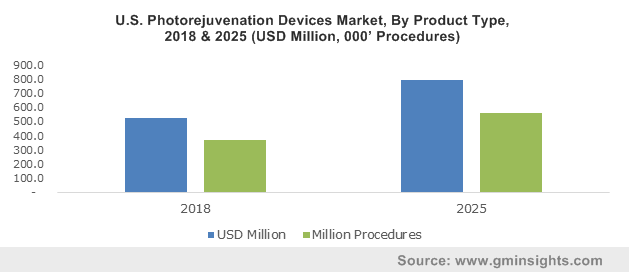Home > Pressrelease > Photorejuvenation Devices Market size to exceed USD 2.5bn by 2025
Photorejuvenation Devices Market size to exceed USD 2.5bn by 2025
- Published Date: August 14, 2019
Photorejuvenation Devices Market size is set to exceed USD 2.5 billion by 2025; according to a new research report by Global Market Insights Inc.
The increasing incidence of skin related problems imposes an enormous burden on healthcare resources. Growing number of aesthetic problems is continuously leading to the adoption of various cosmetic procedures devices. With the growing prevalence, tattoos and hair removal and wrinkle reduction have also become progressively popular in recent years, which has further increased the demand for aesthetic devices in the number of dermatology clinics. Massive demand for laser, Intense pulsed light (IPL), and LED devices are seen in these end-use settings has driven the market growth.
Furthermore, growing awareness regarding reduced side effects with minimally non-invasive cosmetic procedures among the general population will further increase the adoption rate of aesthetic devices. Moreover, increasing disposable income in the emerging economies has further augmented the installations of the cosmetic procedure devices in end-user settings. However, factors like adverse side effects related to the cosmetic treatments, and high cost related with the aesthetic devices might hamper the market growth.

Get more details on this report - Request Free Sample PDF
The intense pulse light segment of photorejuvenation devices market was valued around 680 million in 2018 and will witness significant growth over the forthcoming years. Intense pulse light devices work on the principle of selective photothermolysis, and the application of such devices can be used for a broad range of targets. Features like advanced cooling methods, large treatment spot size, rapidity of treatment, and minimal collateral tissue injury, intense pulsed light is considered as the preferred treatment of facial telangiectasias, rosacea, and pigment on the chest, face, and hands.
A portable/handheld photorejuvenation segment held over a 30% revenue share in 2018 and is expected to increase its revenue share over the forecast period. Recently portable devices are preferred over the standalone device as it reduces the treatment cost and hospital stays.
The home care settings segment registered a growth rate of 6.8% over the forecast period. Factors like less treatment cost, and preventive healthcare are some of the factors favoring segmental growth. Photorejuvenation devices offers affordable and effective home treatments which increases the segmental revenue of home care settings.
Browse key industry insights spread across 170 pages with 199 market data tables & 8 figures & charts from the report, “Photorejuvenation Devices Market Size By Product (Intense Pulsed Light (IPL), Laser Equipment { Ablative Fractional Laser [CO2 Laser, Erbium YAG Laser ], Non-ablative Fractional Laser [Nd: YAG Laser, Er: Glass Laser]}, LED Equipment), By Modality (Standalone Photorejuvenation Devices, Portable/Handheld Photorejuvenation Devices), By End-use (Hospitals, Dermatology Clinics, Home Care Settings), Industry Analysis Report, Regional Outlook (U.S., Canada, Germany, UK, France, Spain, Italy, Japan, China, India, Australia, South Korea, Brazil, Mexico, Argentina, Saudi Arabia, South Africa, UAE), Application Potential, Competitive Market Share & Forecast, 2019 – 2025” in detail along with the table of contents:
https://www.gminsights.com/industry-analysis/photorejuvenation-devices-market
North America photorejuvenation devices market held more than USD 500 million in 2018 and will grow substantially during the forecast period. The North America region is anticipated to hold maximum market share in the market due to the continuous advancements of technology in the aesthetic industry. Furthermore, the growing advent of social media in the region is making information available to everyone, which is making people more aware of cosmetic procedures. Rising awareness among the general population about the cosmetic procedures are likely to pose a positive impact on the sales of cosmetic procedures devices in the region, resulting in considerable growth in the market size.
Notable business players operational in photorejuvenation devices market include Hologic (Cynosure), Lumenis, Syneron Medical, Lynton Lasers, EL.EN. S.p.A. (Deka Mela S.r.l.), Cutera, Fotona, Lutronic Corporation, and Beijing Nubway S & T. Various initiatives undertaken by business players such as mergers and acquisitions to increase their market presence. For instance, in February 2017, Hologic acquired Cynosure. This acquisition helped the company to expand its product portfolio in the aesthetic industry. Similarly, In April 2019, Lumenis launched new platform, the Legend Pro+. The Legend Pro+ is a body and face platform that offers immediate results with minimal pain, long-term efficacy, and downtime, with no need for anesthesia. The platform provides a complete toolkit of non-invasive and minimally invasive technologies to create tailor-made treatments.
Photorejuvenation devices market research report includes in-depth coverage of the industry with estimates & forecast in terms of revenue in USD million from 2014 to 2025, for the following segments:
Photorejuvenation Devices Market By Product, 2014-2025 (USD Million)
- Intense Pulsed Light (IPL)
- Laser Equipment
- Ablative Fractional Laser
- CO2 Laser
- Erbium YAG Laser
- Non-ablative Fractional Laser
- Nd: YAG Laser
- Er: Glass Laser
- Others
- Ablative Fractional Laser
- LED Equipment
Photorejuvenation Devices Market By Modality, 2014-2025 (USD Million)
- Standalone Photorejuvenation Devices
- Portable/Handheld Photorejuvenation Devices
Photorejuvenation Devices Market By End-use, 2014-2025 (USD Million)
- Hospitals
- Dermatology Clinics
- Home Care Settings
- Others
The above information is provided for the following regions and countries:
- North America
- U.S.
- Canada
- Europe
- Germany
- UK
- France
- Spain
- Italy
- Asia Pacific
- Japan
- China
- India
- Australia
- South Korea
- Latin America
- Brazil
- Mexico
- Argentina
- Middle East Asia & Africa
- Saudi Arabia
- South Africa
- UAE